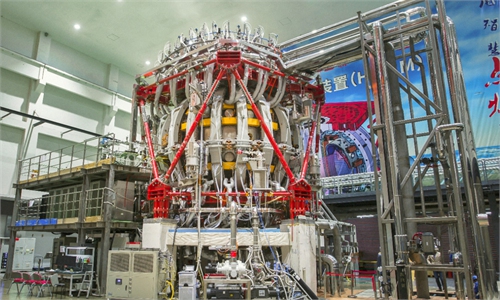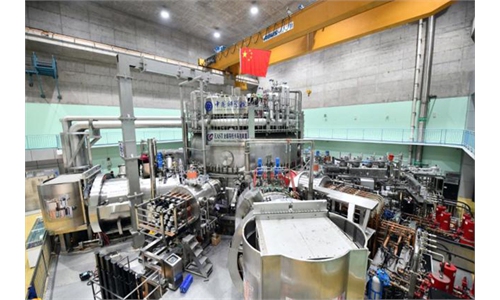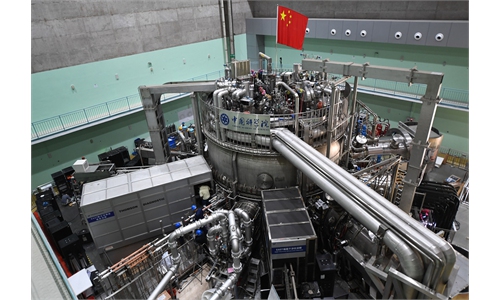CPC-led scientific innovation breaks foreign tech blockade to make strides in ‘artificial sun’ research
Editor's Note:
Who is the Communist Party of China (CPC)? What is the CPC's role in the new era?
The CPC has grown into one of the largest parties in the world in the process of leading the Chinese people to seek liberation and happiness, making China as strong and prosperous as it is today.
As the CPC ushers the nation into a new era of development, the past decade has witnessed great achievements in national strength and prosperity, with people's confidence and recognition of this path rising to unprecedentedly high levels.
With more than 95 million members, the CPC will convene its 20th National Congress in the second half of the year, which is expected to guide the country's development and policymaking. Ahead of the meeting, the Global Times is publishing a series of stories to help the world understand the CPC in the new era, through the stories of CPC members working on the frontlines of various fields, as well as through observations by respected scholars.
In this story, a top-notch scientist leading China's new-generation "artificial sun" team elaborates on his understanding of the CPC's inspiring thoughts on scientific and technological innovation.
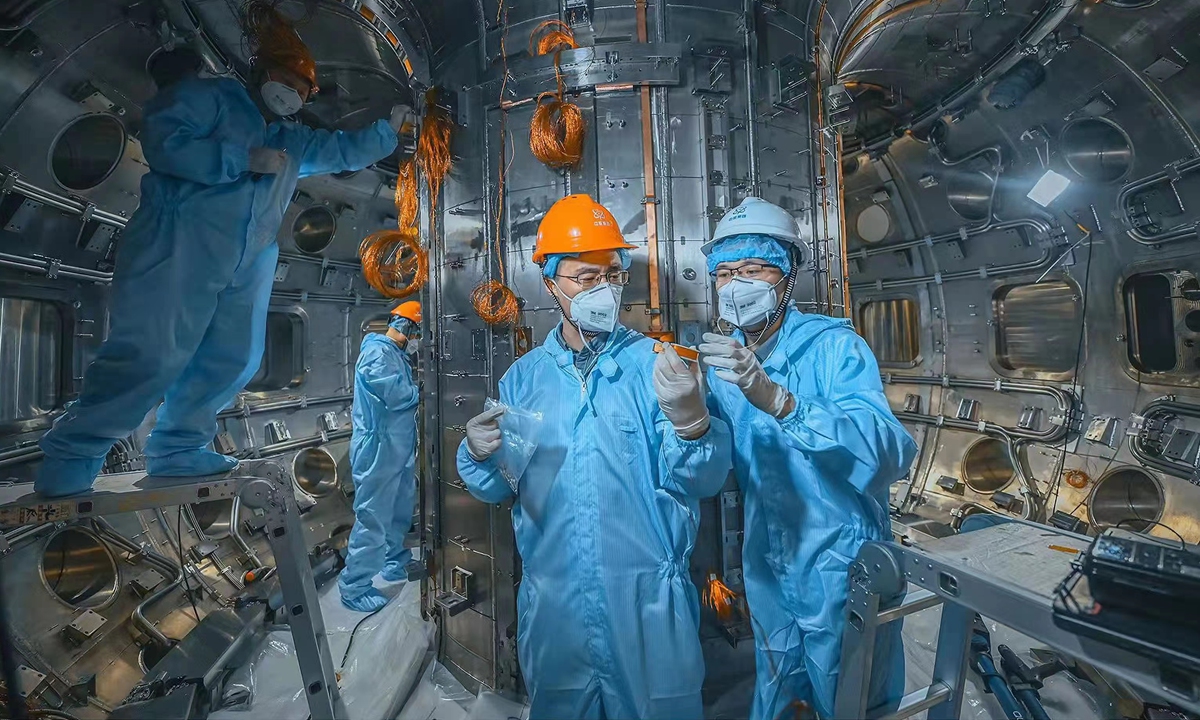
In December 2020, the new generation of the "artificial sun" developed by the Southwestern Institute of Physics under the state-owned China National Nuclear Corporation (CNNC) realized its first discharge, laying a solid foundation for the next step of China's independent design and construction of fusion reactors.
The achievement was selected as one of the "Top 10 News of Scientific and Technological Progress in China in 2020," and was praised by Xi Jinping, general secretary of the Communist Party of China Central Committee, in the general assemblies of the members of the Chinese Academy of Sciences and the Chinese Academy of Engineering in May 2021.
Even more exciting is that among the 76 talents who undertook this advanced science project, 57 are under the age of 35, accounting for 75 percent. During this year's May 4th Youth Day, this team also won the 26th China Youth May 4th Medal Collective.
Recently, in an interview with the Global Times, the team shared their stories about how Chinese young scientists broke through the technological blockade abroad, filled domestic gaps and pursued China's "fusion energy dream."
All things grow from the sun
With rich resources, environmental friendliness and inherent safety advantages, the "artificial sun" will become the ideal energy source for human beings to solve the energy and environmental problems and has important strategic significance for China's economic, social development and industrial construction, Zhong Wulyu, deputy director of the Center of Fusion Science under the Southwestern Institute of Physics, told the Global Times in an exclusive interview.
The research of controlled nuclear fusion research has been incorporated into the central government's plan, and once it achieves a technical breakthrough, it will continuously provide clean, safe and efficient energy for people, and will also play an important role in the future energy structure, Zhong said.
However, compared with the mature application of nuclear fission in nuclear power plants, human beings are faced with many challenges to control the thermonuclear fusion reaction.
According to Zhong, although the principle of nuclear fusion sounds simple, the development of fusion energy is a challenge to the scientific and technical limits of mankind, because it requires that the "triple product" of plasma ion temperature, density and energy confinement time to reach a specific value.
"Only when enough energy is released from the fusion reaction can the fusion reactor operate and have a significant energy output to keep the fusion reaction going," Zhong said.
At present, the only full-scale nuclear fusion reactor in the world is the International Thermonuclear Fusion Experimental Reactor (ITER) which is under construction.
"The purpose is to build a nuclear fusion reactor through the joint efforts of the international community to verify the scientific and engineering feasibility of the peaceful use of nuclear fusion energy," Zhong said.
According to China's three-step nuclear energy development strategy, the country aims to independently develop fusion energy reactors. The new generation of the"artificial sun" is an important measure to develop nuclear fusion energy. On December 4, 2020, the device was completed in Chengdu, capital of Southwest China's Sichuan Province, and achieved its first plasma.
The move was a sign China has independently mastered the design, construction and operation technology of large advanced tokamak device, which will lay a solid foundation for the next step of China's independent design and construction of fusion reactors.
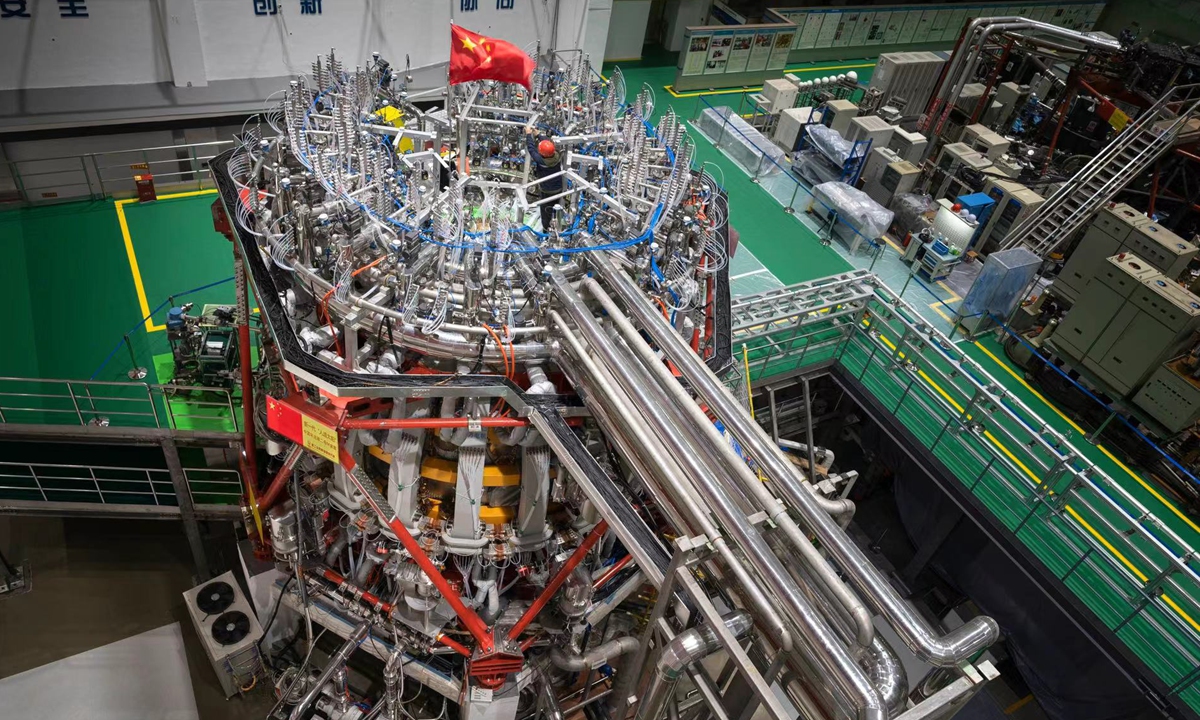
Breaking blockade
The new generation of the "artificial sun" consists of a vacuum chamber, a coil system, a generator set and a support structure. It adopts advanced structure and control mode, and has made many breakthroughs in the design of the device, research and development of special materials, and key components. Behind China's intelligent manufacturing, there are inspirational stories about breaking technological blockade and filling domestic gaps.
Take the vacuum chamber as an example, this device provides a super-vacuum environment for the "artificial sun" discharge experiment, which is lower than the vacuum of the space environment. In the early stage of design and development, the team visited more than 10 large manufacturing enterprises, but was told that they could not produce the material due to high design accuracy, difficulties in manufacturing, and a lack of relevant experiences.
The team then turned the design parameters into a piece of drawings so that the factories could manufacture the vacuum chamber based on hand drawings.
After six years of hard exploration, the team has produced China's first D-shaped section ultra-high vacuum vessel, and the related technical indicators have reached an international leading level.
In order to ensure the performance of the device to meet the needs of physical experimental research, the technical difficulty and process complexity of the "artificial sun" have increased greatly, constantly challenging the limit.
However, our team's perseverance and pioneering spirit have constantly overcome key technical problems and broken through foreign technological blockades, Zhong said.
As the US banned the sale of the high-strength expansion bolts needed to build the artificial sun, we had to start from scratch. We found a breakthrough from the vast literature, through hundreds of material comparison and thousands of trial production, and finally conquered the key technology. Breaking the blockade of foreign countries, we produced a large size and high strength expansion bolt, which reduced the production cost by nearly 90 percent, Zhong said.

International cooperation
In 2006, China, the European Union, the US, Russia, Japan, South Korea and India signed an agreement on the launch of the ITER project, which is one of the largest and most far-reaching international scientific projects in the world and the largest international scientific and technological cooperation project that China has participated in as an equal.
According to Zhong, the project is the largest among more than 30 major fusion research institutes. "China has joined the ITER project as an 'equal partner' and contributed about 9 percent, of which more than 70 percent is in the form of in-kind contribution, namely the research and development of ITER components.
China has delivered relevant tasks on time, with high standards and quality, which is fully recognized by all parties involved," Zhong said.
While contributing to the ITER project, Zhong believes that by deepening international cooperation and exchanges, China is also learning from the existing successful experience in the design, construction and operation of the international controlled fusion experimental device to strengthen its shortcomings.
In September 2020, CNNC successfully won the largest construction contract of ITER project, which includes the installation of the core components of an ITER device - as important as the heart of the human body.
The "artificial sun" team is responsible for sending management and technical experts to provide important technical support for the installation project and take charge of the implementation of some special installation processes.
In the past 10 years, China's fusion research has seen great changes, from "following other countries," to "running alongside them," to even "leading them in some key technological areas." The "artificial sun" team has cultivated a batch of great talents, Zhong told the Global Times.
"Talent is the most key factor for science and technology innovation. The measures taken by the Communist Party of China Central Committee have played an important role in driving the great changes in China's technological innovation development over the past decade. As a scientist, we should actively respond to the call of the CPC Central Committee, carry forward the nuclear industry spirit of the new era, stick to the original aspiration of developing fusion energy, and promote self-reliance in science and technology," Zhong said.
Who is the Communist Party of China (CPC)? What is the CPC's role in the new era?
The CPC has grown into one of the largest parties in the world in the process of leading the Chinese people to seek liberation and happiness, making China as strong and prosperous as it is today.
As the CPC ushers the nation into a new era of development, the past decade has witnessed great achievements in national strength and prosperity, with people's confidence and recognition of this path rising to unprecedentedly high levels.
With more than 95 million members, the CPC will convene its 20th National Congress in the second half of the year, which is expected to guide the country's development and policymaking. Ahead of the meeting, the Global Times is publishing a series of stories to help the world understand the CPC in the new era, through the stories of CPC members working on the frontlines of various fields, as well as through observations by respected scholars.
In this story, a top-notch scientist leading China's new-generation "artificial sun" team elaborates on his understanding of the CPC's inspiring thoughts on scientific and technological innovation.

Scientists discuss the difficulties in installing vacuum chamber of the new-generation "artificial sun." Photo: Courtesy of the Southwestern Institute of Physics
The sun provides light and heat for the growth of all things on earth through nuclear fusion reactions. This principle of energy generation gives human inspiration - controlled nuclear fusion could be used to form an "artificial sun" so that humans could develop a steady stream of new clean energy. The technology has become a focus on the global technology powerhouse and China's scientific research and innovation in this field ranks top in the world.In December 2020, the new generation of the "artificial sun" developed by the Southwestern Institute of Physics under the state-owned China National Nuclear Corporation (CNNC) realized its first discharge, laying a solid foundation for the next step of China's independent design and construction of fusion reactors.
The achievement was selected as one of the "Top 10 News of Scientific and Technological Progress in China in 2020," and was praised by Xi Jinping, general secretary of the Communist Party of China Central Committee, in the general assemblies of the members of the Chinese Academy of Sciences and the Chinese Academy of Engineering in May 2021.
Even more exciting is that among the 76 talents who undertook this advanced science project, 57 are under the age of 35, accounting for 75 percent. During this year's May 4th Youth Day, this team also won the 26th China Youth May 4th Medal Collective.
Recently, in an interview with the Global Times, the team shared their stories about how Chinese young scientists broke through the technological blockade abroad, filled domestic gaps and pursued China's "fusion energy dream."
All things grow from the sun
With rich resources, environmental friendliness and inherent safety advantages, the "artificial sun" will become the ideal energy source for human beings to solve the energy and environmental problems and has important strategic significance for China's economic, social development and industrial construction, Zhong Wulyu, deputy director of the Center of Fusion Science under the Southwestern Institute of Physics, told the Global Times in an exclusive interview.
The research of controlled nuclear fusion research has been incorporated into the central government's plan, and once it achieves a technical breakthrough, it will continuously provide clean, safe and efficient energy for people, and will also play an important role in the future energy structure, Zhong said.
However, compared with the mature application of nuclear fission in nuclear power plants, human beings are faced with many challenges to control the thermonuclear fusion reaction.
According to Zhong, although the principle of nuclear fusion sounds simple, the development of fusion energy is a challenge to the scientific and technical limits of mankind, because it requires that the "triple product" of plasma ion temperature, density and energy confinement time to reach a specific value.
"Only when enough energy is released from the fusion reaction can the fusion reactor operate and have a significant energy output to keep the fusion reaction going," Zhong said.
At present, the only full-scale nuclear fusion reactor in the world is the International Thermonuclear Fusion Experimental Reactor (ITER) which is under construction.
"The purpose is to build a nuclear fusion reactor through the joint efforts of the international community to verify the scientific and engineering feasibility of the peaceful use of nuclear fusion energy," Zhong said.
According to China's three-step nuclear energy development strategy, the country aims to independently develop fusion energy reactors. The new generation of the"artificial sun" is an important measure to develop nuclear fusion energy. On December 4, 2020, the device was completed in Chengdu, capital of Southwest China's Sichuan Province, and achieved its first plasma.
The move was a sign China has independently mastered the design, construction and operation technology of large advanced tokamak device, which will lay a solid foundation for the next step of China's independent design and construction of fusion reactors.

The new generation of "artificial sun" HL-2M in the Southwestern Institute of Physics Photo: Courtesy of the Southwestern Institute of Physics
Breaking blockade
The new generation of the "artificial sun" consists of a vacuum chamber, a coil system, a generator set and a support structure. It adopts advanced structure and control mode, and has made many breakthroughs in the design of the device, research and development of special materials, and key components. Behind China's intelligent manufacturing, there are inspirational stories about breaking technological blockade and filling domestic gaps.
Take the vacuum chamber as an example, this device provides a super-vacuum environment for the "artificial sun" discharge experiment, which is lower than the vacuum of the space environment. In the early stage of design and development, the team visited more than 10 large manufacturing enterprises, but was told that they could not produce the material due to high design accuracy, difficulties in manufacturing, and a lack of relevant experiences.
The team then turned the design parameters into a piece of drawings so that the factories could manufacture the vacuum chamber based on hand drawings.
After six years of hard exploration, the team has produced China's first D-shaped section ultra-high vacuum vessel, and the related technical indicators have reached an international leading level.
In order to ensure the performance of the device to meet the needs of physical experimental research, the technical difficulty and process complexity of the "artificial sun" have increased greatly, constantly challenging the limit.
However, our team's perseverance and pioneering spirit have constantly overcome key technical problems and broken through foreign technological blockades, Zhong said.
As the US banned the sale of the high-strength expansion bolts needed to build the artificial sun, we had to start from scratch. We found a breakthrough from the vast literature, through hundreds of material comparison and thousands of trial production, and finally conquered the key technology. Breaking the blockade of foreign countries, we produced a large size and high strength expansion bolt, which reduced the production cost by nearly 90 percent, Zhong said.

GT
International cooperation
In 2006, China, the European Union, the US, Russia, Japan, South Korea and India signed an agreement on the launch of the ITER project, which is one of the largest and most far-reaching international scientific projects in the world and the largest international scientific and technological cooperation project that China has participated in as an equal.
According to Zhong, the project is the largest among more than 30 major fusion research institutes. "China has joined the ITER project as an 'equal partner' and contributed about 9 percent, of which more than 70 percent is in the form of in-kind contribution, namely the research and development of ITER components.
China has delivered relevant tasks on time, with high standards and quality, which is fully recognized by all parties involved," Zhong said.
While contributing to the ITER project, Zhong believes that by deepening international cooperation and exchanges, China is also learning from the existing successful experience in the design, construction and operation of the international controlled fusion experimental device to strengthen its shortcomings.
In September 2020, CNNC successfully won the largest construction contract of ITER project, which includes the installation of the core components of an ITER device - as important as the heart of the human body.
The "artificial sun" team is responsible for sending management and technical experts to provide important technical support for the installation project and take charge of the implementation of some special installation processes.
In the past 10 years, China's fusion research has seen great changes, from "following other countries," to "running alongside them," to even "leading them in some key technological areas." The "artificial sun" team has cultivated a batch of great talents, Zhong told the Global Times.
"Talent is the most key factor for science and technology innovation. The measures taken by the Communist Party of China Central Committee have played an important role in driving the great changes in China's technological innovation development over the past decade. As a scientist, we should actively respond to the call of the CPC Central Committee, carry forward the nuclear industry spirit of the new era, stick to the original aspiration of developing fusion energy, and promote self-reliance in science and technology," Zhong said.

